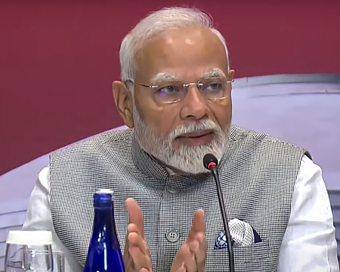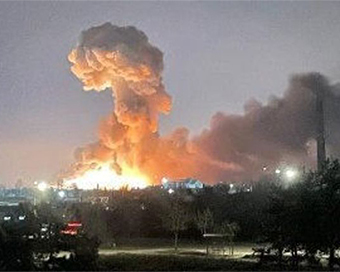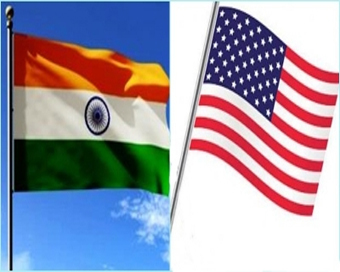 PM Modi visit USA
PM Modi visit USA Only the mirror in my washroom and phone gallery see the crazy me : Sara Khan
Only the mirror in my washroom and phone gallery see the crazy me : Sara Khan Karnataka rain fury: Photos of flooded streets, uprooted trees
Karnataka rain fury: Photos of flooded streets, uprooted trees Cannes 2022: Deepika Padukone stuns at the French Riviera in Sabyasachi outfit
Cannes 2022: Deepika Padukone stuns at the French Riviera in Sabyasachi outfit Ranbir Kapoor And Alia Bhatt's Wedding Pics - Sealed With A Kiss
Ranbir Kapoor And Alia Bhatt's Wedding Pics - Sealed With A Kiss Oscars 2022: Every Academy Award Winner
Oscars 2022: Every Academy Award Winner Shane Warne (1969-2022): Australian cricket legend's life in pictures
Shane Warne (1969-2022): Australian cricket legend's life in pictures Photos: What Russia's invasion of Ukraine looks like on the ground
Photos: What Russia's invasion of Ukraine looks like on the ground Lata Mangeshkar (1929-2022): A pictorial tribute to the 'Nightingale of India'
Lata Mangeshkar (1929-2022): A pictorial tribute to the 'Nightingale of India' PM Modi unveils 216-feet tall Statue of Equality in Hyderabad (PHOTOS)
PM Modi unveils 216-feet tall Statue of Equality in Hyderabad (PHOTOS)The 15th Hockey India Senior Men National Championship, set to take place from April 4 to
- Mensik denies Djokovic 100th title in Miami final
- KIPG: Son of a vegetable vendor, Bihar’s Jhandu Kumar eyes Worlds, 2028 Paralympics
- Hardik Singh credits hard work and team unity for receiving HI Midfielder of the Year award
- Djokovic, Alcaraz land in same half of Miami draw
- India to host 2nd Asian Yogasana Championships from March 29 to 31
India-US trade deal likely to materialise by fall 2025: Morgan Stanley Last Updated : 11 Mar 2025 01:50:46 PM IST 
India-US trade deal likely to materialise by fall 2025: Morgan Stanley A trade deal between India and the US would likely take some time but will materialise by the fall 2025, according to a Morgan Stanley report released on Tuesday.
While India is exposed to direct tariff risks, the global brokerage believes that on balance, the country is less exposed to global goods trade slowdown considering that it has the lowest goods exports to GDP ratio in Asia.
The report highlighted that significant uncertainty still remains on the quantum of the tariff increase that India would be subjected to given the US administration has yet to fully clarify how reciprocal tariffs would be imposed.
According to the report, while India can eventually reach a trade deal with the US, it would be relatively more challenging given the multiple bilateral trade issues.
“As it is, officials have guided for a Fall (September-November) 2025 timeline for a possible US-India free trade agreement. This would imply that India would not be able to avoid reciprocal tariffs scheduled for April 2nd and that tariffs could likely go up in the meantime until at least the trade deal is reached,” it further stated.
The report underscored that WTO’s most-favoured-nation principle also prevents India from adjusting its tariffs on US imports first without extending this to other WTO members, unless this happens under a free-trade agreement.
Under the WTO agreements, countries cannot normally discriminate between their trading partners. Grant someone a special favour (such as a lower customs duty rate for one of their products) and you have to do the same for all other WTO members.
Some exceptions are allowed. For example, countries can set up a free trade agreement that applies only to goods traded within the group — discriminating against goods from outside. Or they can give developing countries special access to their markets. Or a country can raise barriers against products that are considered to be traded unfairly from specific countries. And in services, countries are allowed, in limited circumstances, to discriminate.
But the agreements only permit these exceptions under strict conditions. In general, MFN means that every time a country lowers a trade barrier or opens up a market, it has to do so for the same goods or services from all its trading partners — whether rich or poor, weak or strong, the report observed.
It further states that from a tariff risk perspective, India is among the more exposed economies to further tariff escalation (i.e. reciprocal tariffs) within Asia given India imposes very high tariff rates on select imports, existence of high non-tariff barriers and the size of its goods trade surplus with the US.
Additionally, India is also moderately exposed to potential tariffs on pharmaceutical product exports. President Trump has indicated he will likely impose tariffs on this product category which account for 2.8 per cent of overall exports and 0.3 per cent of GDP.IANS New Delhi For Latest Updates Please-
Join us on
Follow us on








172.31.16.186







